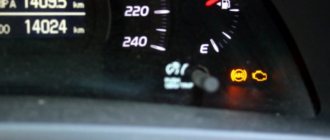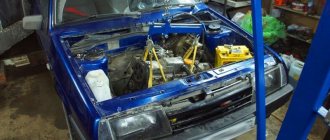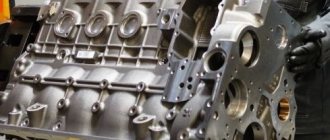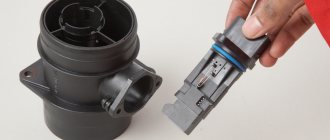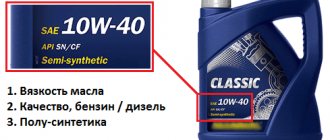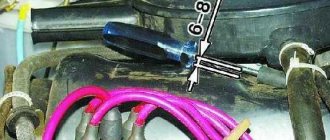Causes of oil on spark plugs
If the candles are covered with oil, then first of all it is necessary to determine exactly which part has the most of it. Many car owners are faced with a situation where only the threads and body are coated with lubricant, while the electrodes are dry and have a normal color (light brown). But it also happens that the entire base ends up in oil.
At the same time, in addition to traces of lubricant on the spark plugs, a malfunction with the engine manifests itself in other ways - deterioration in dynamics, increased exhaust smoke, oil burns. In order for it not to be the cause, it must be eliminated.
Most often, the appearance of grease marks occurs due to wear and damage:
- Valve guides.
- Oil seals.
- Valves.
- Cylinder head gaskets (cylinder head).
- CPG elements (cylinder-piston group).
Traces of lubricant on the body and threads are mentioned for good reason, since oil can get onto the spark plug not only from the cylinder, but also due to external leaks. So, on some cars, a loose fit of the cylinder head cover gasket is considered a “disease”. As a result, candles seep through leaks and get into the wells. Thus, oil accumulates in the wells of the spark plugs and when unscrewing the spark plugs, both the body and the threads are simply smeared in the accumulated lubricant. The problem is “treated” by replacing the gasket and coating it with sealant.
For what reason can an oil leak occur in the engine?
To resolve the problem, it is important to determine the reason for the breakdown. This will save time and money needed for repairs. Possible reasons include:
- Deformation of gaskets and seals. There are a lot of them in the engine and any element can lead to a leak. Oil leaks often occur from under the cylinder block or in the timing belt area.
- There is a problem in the area of the crankcase ventilation system. Gases, as a result of the operation of mechanisms, often break into the crankcase and create excessive pressure on the engine oil. As a result, the oil is squeezed out through the same seals and gaskets.
- Using poor quality lubricant. Buying a counterfeit product can lead to the internal combustion engine starting to overheat and again lead to the loss of quality characteristics of the seals.
- Damage to the oil pan. This reason is the simplest and most banal, but also the most common. When various objects that can damage the car get under the bottom of the car, it will be difficult to avoid a leak. To avoid getting into an unpleasant situation, many motorists place additional protection on their car.
The listed reasons are considered the most common, although other malfunctions may also occur.
We diagnose the breakdown
The penetration of gasoline into the lubricant can be judged by the following factors:
- Motor fluid has become less viscous.
- The lubricant from the dipstick flashes. Oil, without foreign impurities, practically does not burn; if fuel is mixed with it, then checking this is quite simple. Place the dipstick with a certain amount of engine fluid near the flame of the lighter. If there is gasoline in the lubricant, there will be a bright flash on the dipstick.
- Increased fuel consumption.
- Reducing the power of the power unit.
- The appearance of extraneous noise in the motor.
- A drop of oil taken from the dipstick, when applied to a napkin or paper, forms a zone of transparent material around itself, which quickly evaporates.
If one of these signs is present, do not panic, try to find and eliminate the cause yourself.
How to find an oil leak
It is not difficult to detect a leak yourself. By inspecting the turbocharger (in diesel engines), the oil pump and the engine itself, you will understand whether there are leaks or not. Occasionally there are situations when it is difficult to see a slight leak. In this case, you should contact a car service.
It is almost impossible to eliminate a leak without overhauling the engine. Even when replacing the leaking gasket, you will have to remove the block cover, not to mention disassembling the engine components. Using bad oil is the only case in which it is not necessary to disassemble the engine. You can drain the waste and then fill it with high-quality fluid, but remember that you cannot completely get rid of the old oil. For some time, the engine will contain 3–5% waste, which will be mixed with the new oil filled.
Signs of a Leak
Is it possible to understand that there is a leak? You can find out about this by noticing a dark puddle under the car. It happens that lubricant leaks from under the valve cover lining, oil seals or crankcase gasket. Motor oil can only be mixed with fuel in the engine. It is possible to determine that gasoline has entered the oil liquid by the following signs:
- the viscosity of the oil changed, it became thinner;
- the car oil on the dipstick lights up if you bring the flame close to it;
- A drop of oil on a piece of paper leaves a greasy, growing stain.
About motor oil consumption standards
Before you understand the reasons for the increased consumption of liquid motor lubricant, you need to understand what is considered normal and at what point this phenomenon becomes a problem. After all, “eating” oil is common to all engines; the question is the size of the “appetite”.
When a lot of oil is lost, you have to constantly add it.
We recommend: The best engine cleaners
During operation of the unit, which is in good condition, the amount of lubricant is reduced due to the following technological losses:
- deposits in the form of soot when entering a flash zone or high temperature;
- deposits in the form of dirt, retained by the filter and oil pump screen;
- evaporation and removal of oil vapors through the crankcase ventilation system;
- mud deposits in various hard-to-reach places.
This is what soot deposits look like in a diesel engine
The listed losses are called engine oil consumption due to waste. Ideally, the amount of waste depends on the working volume of the unit. The more powerful the motor, the greater the amount of lubricant it needs to operate, which means that losses increase. In reality, there are many more factors influencing the consumption of lubricants.
The rate of technological losses due to waste is calculated as a share of 0.2-0.3% of fuel consumption per 100 km. If we take as an example fuel consumption of 6 liters per 100 km, then the waste should be in the range of 12-18 ml. That is, adding 1.2 liters of oil over a mileage of 10 thousand km is considered the norm for such an engine.
Build-up of deposits from the back of the valve disc
If the motor consumes more than the specified norm, then there is cause for concern. It is necessary to analyze the causes of the phenomenon and eliminate them, so that at one “wonderful” moment you do not face the repair of the power unit. Indeed, due to forgetfulness or lack of time, you may not replenish the oil level on time, which can result in a drop in pressure, overheating of the piston group, or failure of the crankshaft plain bearings (liners).
Increased oil consumption: symptoms and causes
The nature of how the engine consumes oil is reflected in the varying intensity and stability of the problem. The engine “eats” the lubricant:
- in an insignificant amount - slightly more than normal;
- in unrealistically large quantities;
- constantly and in the same volumes;
- “swooping”: the flow rate is either normal or increased.
The first sign of overconsumption, i.e. a small amount of it, is the lighting of the corresponding light on the instrument panel. Having noticed this problem (if it is not associated with the regular addition of motor fluid), you need to determine the nature of the “disappearance” of the oil, check the symptoms, the manifestation of which indicates the possible causes of the problem.
Oil consumption is accompanied by blue smoke from the muffler
This symptom is usually accompanied by excessive consumption of lubricant, and sometimes also by a drop in the power of the power plant. Why does the engine “eat” oil? It is obvious here that, most likely, the oil is burning somewhere in the engine. To make sure of this, it is advisable to test the exhaust with a gas analyzer.
Or you can do it the folk way: lean a clean piece of paper against the pipe for a few seconds. The presence of greasy spots indicates the presence of oil in the exhaust. What are the reasons for the “phenomenon”?
Complete or partial failure of the PCV system (forced crankcase ventilation)
The symptom of this problem can be very pronounced: the car eats oil and smokes, but as soon as the amount of material on the dipstick reaches a minimum, everything returns to normal. But the point is this: if one of the hoses or the valve is clogged, then the flow of air for the formation of a combustible mixture is disrupted. As a result, the system only works halfway: through the remaining free ventilation pipe. This is fraught with the appearance of oil in the air filter, as well as coking of the throttle valve. The result will be an increase in the vacuum in the crankcase, which increases the waste of oil due to waste. If the situation worsens and two channels become clogged, then the lubricant can be squeezed out into the hole for the dipstick, or, even worse, through the engine seals.
Excessive oil consumption produces black smoke
Why does the car “eat” oil in this case? The primary reason here is the expired service life of the piston oil scraper rings. However, they may break, but such a phenomenon is rare and is typical only for low-quality products. As practice shows, often the cylinders wear out along with the rings, which will have to be bored to the nearest repair size.
As the gap between the cylinder walls and the outer surface of the rings increases, the latter are simply unable to completely remove the oil remaining in the combustion chamber, and when a spark is formed, it turns into smoke and flies out through the exhaust system (the car eats oil, smokes like a kerosene stove, and falls compression). There are other reasons for high oil consumption, accompanied by black exhaust.
Problems in the gas distribution mechanism
First you should check the valves and their guides. Wear of these pairs leads to the appearance of backlash: that is, the rod in the seat begins to dangle, as a result of which the valve stem seal is destroyed, which leads to the appearance of oil in the combustion chamber. Obviously, replacing the sealing seals alone is not enough: you will also have to change the valves with bushings included.
But it also happens that the reason for oil penetration into the combustion chamber is only the valve stem seals, which have already exhausted their service life. They become rigid, lose their elasticity, become coked and no longer tightly grip the valve stem. There is only one way out - replacing the valve stem seals, which can be done directly on the car without removing the cylinder head.
Destruction of the neutralizer
The engine “eats” oil for this reason only if you had to remove a damaged catalytic converter. If it is dismantled carelessly, its fragments and particles can get into the combustion chamber and mechanically damage the cylinder walls: after starting the engine, scratches will remain on them and oil will begin to penetrate into the combustion chamber.
High pressure fuel pump malfunction
This “sore” is observed in diesel units. A poorly functioning fuel injection pump can cause excessive oil consumption. In this case, it is injected into the cylinders along with the fuel and burns there, producing smoke in the exhaust.
Filler neck defect
This seemingly minor spare part can also cause consumables to leak. The fact is that with increased pressure in the cylinders, the rubber seal of the cover is simply not able to contain the liquid escaping out. The result is immediately visible: traces of oil at the neck. The problem is solved by purchasing a new cover. If this does not help, then you will have to look for the cause of the increased pressure in the engine components.
Visually visible leaks
If your engine is in oil, there are not many reasons. Almost all modern car factories guarantee the integrity of engine gaskets during its service life. However, emergency situations introduce their own adjustments to this guarantee.
This may be a consequence, for example, of frequent overheating of the engine (1-2 times can pass without consequences), or sudden temperature changes (which is not uncommon in the harsh Russian climate). All this leads to warping of the rubber-metal gaskets or their burning out. The way out of the situation is to replace the damaged elements.
Deformation of the cylinder head is especially dangerous: this is fraught not only with oil getting into the combustion chamber: coolant can get into the engine crankcase, which will lead to a decrease in the viscosity of the lubricant and rapid wear of most engine components and assemblies. The problem is determined by a high (significantly higher than the maximum) oil level on the dipstick, plus the car eats oil and smokes. To check the cylinder head gasket, the latter will have to be removed. The defect can be determined visually: traces of breakdown or burnout will be visible.
It is worth noting: even if everything is in order with the gasket, it must be replaced.
A leak in the heat exchanger means that mixing of coolant and oil can occur not only when there is a breakdown or burnout of the cylinder head gasket. Highly loaded engines have a heat exchanger that equalizes the temperature of antifreeze and lubricant. The use of such a unit makes it possible to operate the motor in a uniform temperature regime, which minimizes stress in the rubbing parts of the unit. You can determine if the heat exchanger is broken not only by the dipstick (as in the previous case), but also by the open cap of the expansion tank: under it you will see white-yellow foam.
The appearance of cracks in the cooling jacket
Quite an unpleasant defect. It is easy to determine: due to oil getting into the antifreeze, it begins to be squeezed out literally from under all the gaskets, “thanks” to the increased level of coolant. As a result, the engine is in oil, the reasons are not entirely clear.
If you pull out the dipstick, the level will be higher than the maximum, and on the rod itself you will see droplets of liquid that are not similar in color and consistency to the lubricant composition. The problem is compounded by the fact that the cracks can be microscopic in size. Repairs in this case will not be cheap and can only be carried out in a specially equipped service center with welding equipment.
Leakage from crankshaft seals
When the engine is in oil from below, it is not so difficult to determine the cause. A puddle under the car at the location of the oil seals (front and rear) forms when the engine is running. Place the car in the inspection hole, turn off the engine and wipe off the areas stained with oil. Start the engine, and, being under the car, you will see where the lubricant is leaking from. Worth mentioning: the seals themselves are inexpensive, but to replace them you will have to disassemble the entire engine. If you are doing the repair yourself, be sure to properly tighten the bolts; failure to do so may also cause a leak.
Oil filter
This important element of the lubrication system can leak if tightened loosely or, conversely, too tightly. In the first case, the oil will seep through the rubber gasket (it comes with the filter and is glued to it at the factory). To solve the problem, just tighten the part more tightly.
In the second case, the gasket is crushed and ruptured. In some cars, the filter is located at the bottom and sometimes has no protection. If you hit an obstacle, it may become deformed, which also leads to lubricant leakage.
The engine eats oil, but does not smoke: reasons
The main reason for this phenomenon is visible leaks, this was discussed above. But what to do if a thorough examination of the car from above and below, with the engine running and turned off, did not reveal obvious signs of leakage. However, you should not rush to conclusions: if the engine eats oil but does not smoke, there are still leaks, but they are barely noticeable. The same applies to smoke: try sharply pressing the gas pedal or switching to another gear when accelerating: the exhaust will probably turn gray or black. At the same time, there is no smoke in “neutral” or parking mode. As for invisible leaks, the most typical places of their formation are discussed below.
Turbine
This unit not only needs oil, but is also cooled by it. In the event of severe shaft wear, the lubricant gradually flows onto the turbine and pump wheel, then into the intake and combustion chamber, and from there into the muffler. Result: black smoke. Turbine diagnostic methods are described in detail here.
Problems with the distributor (ignition distributor)
If your engine is equipped with this device, oil may leak through the O-ring. To determine this problem, remove the distributor cover and inspect its “insides”: if there is little, it will be noticeable. An additional symptom is a characteristic crackling sound when the ignition distributor operates. Changing the ring is not difficult, but then you will have to reset the ignition.
Camshaft plug defective
This part is usually installed on engines with a pair of camshafts (it can also be found on a single shaft if the engine is not equipped with a distributor). If there is a defect on the plug, oil will leak through the o-ring. The way out of the situation is to replace the part.
There is a nuance: the plugs are plastic or rubber. The first ones are quick to put on, but less reliable. The latter last longer, but require careful installation to achieve good tightness.
What can be done
If the spark plugs are filled with oil, then identifying the cause is not so difficult, but eliminating it can be a troublesome task.
If we talk about the case of a leaking valve cover gasket described above, then everything is very simple - oil is noticed in the spark plug wells - the sealing element requires replacement.
It’s worse if grease is found on the bottom of the spark plug (and it can be on one, several or all spark plugs).
A compression test will partially help here. If the rings are stuck or the valves do not fit tightly, it will certainly decrease. If there are traces of lubricant on the spark plugs, but the compression is fine or even increased (which happens due to the oil present in the combustion chamber, which acts as a seal in the existing gaps), you will have to disassemble the cylinder head to assess the condition of the oil seals and valve guides. In general, it is the last two elements that are the most common reasons for lubricant getting into the cylinders, including spark plugs.
We recommend: Changing the oil in a Volkswagen Polo automatic transmission
Do not forget that the engine itself has a certain resource. If it is noticed that all the spark plugs are in oil, and the compression has dropped significantly below normal, it may be worth considering a major overhaul, since the degree of engine wear has reached critical levels.
How can you tell if your engine is eating oil?
Loss of motor oil (hereinafter referred to as MM) in the engine is a common problem and headache for many car enthusiasts. But how can you determine at home and understand why the engine is eating oil? There are several ways to check.
| So, we determine visually that the motor consumes MM: | |
| If the car is yours and only you drive it, then first learn to monitor the MM level in the engine. When replacing the fluid, its level should be midway between o and “MAX” of the dipstick to check the consumables. If the fluid goes away by about half a centimeter after 5 thousand runs since replacing the MM, then this is quite normal and there is no need to worry. It’s just that some of the liquid goes into soot and there’s no escape from it. You need to get used to the fact that lubricant must be periodically added to the engine. | |
| If the vehicle is not yours, and when purchasing it you want to determine whether a good part of the MM goes into the engine, then open the engine cover where the oil is poured. If it is perfectly clean, then be sure that the oil does not leak into the engine in catastrophic volumes. | |
| Also look inside the neck and evaluate the color of the engine from the inside. If the engine parts are clean or have a yellowish tint, this also indicates that the engine does not “eat” oil. | |
| It is necessary to visually evaluate the lubricant in the motor. If its color is very dark or close to black, and you see a layer of deposits on the filler cap, then this is the first sign that the fluid in the engine has been used for a long time. | |
| If there are leaks in the vehicle’s engine, then the MM should be light, since for the normal functioning of the engine it is necessary to regularly add new oil. | |
| Watch the exhaust fumes. If the MM goes into the engine, the exhaust color may have a bluish tint. This occurs as a result of a significant amount of liquid entering the combustion chamber. Subsequently, this can lead to carbon deposits on the engine pistons, valves, and on the surface of the cylinder head combustion chamber. | |
| Also check the spark plugs - if oil goes into the engine, carbon deposits will form on the electrodes of the spark plugs - this is also a sign of a MM leak. | |
| You should also remember to check the vehicle engine compression. This refers to checking the pressure in the cylinders. If the readings are too high, keep in mind that there is something wrong with the pressure in your engine. | |
Using these indicators, you can check and determine the flow of the MM into the motor. Only by determining why fluid is leaking into the engine can you understand what to do next.
Carbon deposits on a car engine
Reasons requiring specialist intervention
The most unpleasant reason for gasoline getting into the oil of an engine with an injector is a malfunction of the piston group. The cylinder walls may be deformed, cracked, scratched or chipped. With prolonged use of oil with poor cleaning properties, the oil scraper rings become coked.
A breakdown is determined by measuring the compression in each cylinder. Measurements may differ from each other by one unit. If there is a larger gap in the compression values, we can talk about a malfunction in the specified cylinder. In such a situation, it is impossible to do without a major engine overhaul.
You can try to restore coked oil scraper rings using special chemicals, but such manipulations do not always produce a good effect.
What does increased engine oil consumption mean?
Increased consumption - general losses determined by measuring the level using a dipstick and sensors, which are expressed in a decrease in the level in the oil pan. It can evaporate in the cylinders; leak out through leaks - leak through crankshaft oil seals, cylinder block gasket, oil filter housing gasket, intake valve caps.
Many drivers are faced with such a problem as increased oil consumption.
Increased engine oil consumption is associated with overheating and abrasion of the piston rings; increased viscosity of the lubricant; its poor quality; inevitable lubrication of the turbocharger; unfavorable engine operating conditions.
There are no specific standards for oil consumption. The consumption rate for different cars, depending on age, displacement, make and model, can vary greatly.
Why does the engine oil level rise?
So, to clarify the situation regarding the level of the main motor fluid, you need to consider why it is dangerous and what are the original sources of the problem.
How to measure the oil level correctly
Initially, in order to avoid unnecessary movements, the oil level must be measured correctly so that there is not too much or little oil in the engine.
How much oil should be on the dipstick? Most power units for these purposes are equipped with a special probe, which allows you to accurately determine the parameter.
Next is the measurement process:
- The car should be placed on a horizontal surface. You can choose a flat section of the road or do it in a garage with a flat floor.
- Give the engine time to cool. When heated, liquids tend to expand and motor oil is no exception. Plus, the lubricant must drain, since the entire volume of lubricant after the trip is splashed over all working surfaces. Cooling time is usually 20 - 25 minutes. Some experts recommend performing the procedure after an overnight stay, so the result will be the most accurate.
- Remove the dipstick from the channel and wipe it dry with a rag. This manipulation will give a more accurate result.
- Lower the meter into the channel until it stops and then carefully remove it.
Inspecting the needle of the dipstick, you can see the MIN and MAX notches. These are indicators of acceptable levels. The ideal position is for the level to be strictly in the middle between the marks.
The consequences of the fact that there is little or, on the contrary, a lot of oil in the engine are described below in the article.
Dangers of high oil levels
A high oil level in the engine threatens its improper operation and subsequent failure. The volume of lubricating fluid in the engine is strictly calculated by the manufacturer. This sets the required pressure in the pumping system and the optimal viscosity characteristics. When these indicators are violated, excess pressure occurs, leading to the following problems:
- Increased fuel consumption due to increased resistance to fluid and moving parts.
- Worsening cold starts. Due to the large volume of fluid, it is more difficult for the crankshaft to make the first turns. The problem is especially pronounced in cold weather.
- The service life of oil seals and seals is reduced. The more pressure on the seals, the faster they will leak.
- Rapid wear of the oil pump. It is difficult to pump a lot of liquid, so the pump is subjected to heavy load.
- The service life of the exhaust gas cleaning system and particulate filters is reduced. The pressure pushes the fluid into the cylinders through the sealing rings and when it burns it produces a lot of dirt.
Dangers of Low Oil Level
An excessively low point can also have a negative effect. This state of affairs obliges the power unit to experience starvation, which is fraught with serious consequences.
- Frequent overheating of components. Lack of lubrication results in increased friction. What causes overheating?
- Increased engine wear.
- Increased fuel consumption.
- Major failure. Due to severe overheating, the pistons may jam or stick, which can lead to damage and replacement of the motor.
Common problems
The main reason why car oil comes into contact with fuel is severe wear of the compression/oil rings. Gasoline flows into the crankcase, oil enters the combustion chamber. All this indicates that the power unit needs to be overhauled, since it has accumulated many serious faults.
The engine becomes much weaker if the compression of at least one cylinder decreases. Excess fuel in the combustion chamber also does not lead to anything good. Carbon deposits will increase and the engine will constantly overheat. Consequently, the viscosity of the automotive lubricant will change. In other words, the oil will begin to thin out. This is unsafe for an engine operating at high speeds under harsh operating conditions.
The consequences of any malfunction can be minimized if the problem is detected in time. You need to pay attention to the above signs of a leak. Then you won’t have to go to a car service center to have your car’s engine completely repaired. This service is quite expensive, so it is better to know what the main signs of fuel getting into the oil liquid are. This will make it possible to avoid many significant financial expenses.
Design and malfunctions of the crankcase ventilation system
All gasoline engines have a “dual” crankcase ventilation system - one part of it operates at high speeds, and the second - only at idle. This device includes: 1. Tubes made of dense rubber - remove excess gases entering the crankcase and disrupting the normal operation of the engine. Crankcase gases are sucked through the air filter, from where they enter the intake manifold. Units equipped with fuel injection have one suction pipe with a split channel. The larger diameter outlet enters the manifold before the throttle valve, and the smaller one - after it. It is through it that the crankcase is ventilated at idle. 2. Ventilation valve – regulates the pressure of gases entering the manifold. At idle (with slight vacuum) it is in the open state, and closes only with increasing speed. Incorrect operation of the valve leads to the formation of a “lean” mixture, the engine begins to “shake” and it “stalls”. 3. Oil separator - prevents oil vapors from entering the combustion chamber, thereby reducing the formation of soot. When the oil separator becomes clogged with carbon deposits, its normal operation is disrupted, oil penetrates into the air filter, and from there into the intake manifold. The engine starts to smoke. Before eliminating an oil leak in the engine, you should pay attention to the following point: when the tubes - the ventilation channels - become clogged with slag and fumes, the operation of the system will be disrupted, and the exhaust gases will create excess pressure. Most seals will not be able to withstand such a load and will begin to leak gases mixed with oil. It is extremely important to achieve normal crankcase ventilation! You can check the effectiveness of the system in a simple way - by placing a piece of smooth cardboard on the oil filler neck. At a speed of 1000 rpm, the cardboard should be pressed tightly against the surface due to the vacuum created in the crankcase. Note that if the piston group is very worn, then the desired result cannot be achieved even at 2000 rpm. Exhaust gases will "massively" break through the O-rings, turning the fight against leakage into an almost useless exercise. So, we looked at the effect of the crankcase ventilation system on the formation of a leak. Now you need to identify the most problematic points of the engine - those places where leakage occurs most often, and also note possible ways to eliminate this problem.



